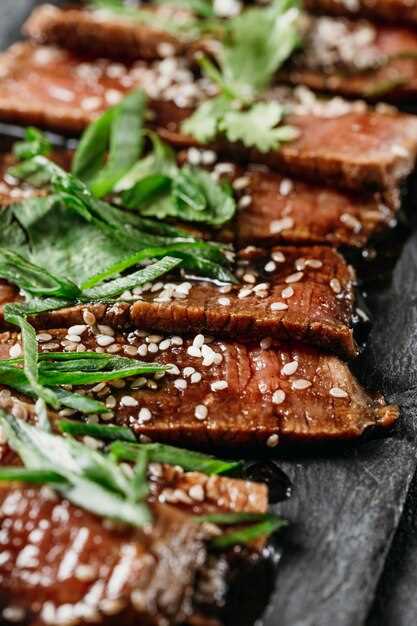Achieve impeccably cooked flank steak with this controlled-temperature water immersion method. Expect a transformative difference compared to traditional cooking: tenderness amplified, moisture retained, and a uniformly pink interior, edge-to-edge. This technique minimizes shrinkage, yielding a larger portion of exquisitely prepared beef.
For peak palatability, aim for an internal temperature of 131°F (55°C) for medium-rare. Precise timing depends on steak thickness; a 1.5-inch (3.8 cm) cut benefits from a 2-hour immersion. Before sealing, generously season with kosher salt, cracked black pepper, and freshly minced garlic – no need for elaborate marinades.
Post-immersion, a scorching sear is paramount. Utilize a cast-iron skillet heated to a smoking point with high-heat oil (such as avocado or grapeseed). Sear each side for 60-90 seconds, achieving a deep mahogany crust. Allow the meat to rest for 10 minutes before slicing against the grain for optimal tenderness. Garnish with a sprinkle of flaky sea salt and freshly chopped parsley.
Perfectly Cooked Flank Steak: Your Immersion Circulator Guide
For medium-rare (130-135°F/54-57°C), set your immersion circulator to 131°F (55°C). This achieves consistent edge-to-edge doneness unobtainable with conventional cooking methods.
Preparing the Meat
Trim excess fat from the flank steak, leaving a thin layer for flavor. Season generously with salt, freshly ground black pepper, granulated garlic, and smoked paprika. Vacuum seal the steak in a food-safe bag, ensuring minimal air pockets.
Cooking Times & Considerations
For a 1-inch thick flank steak, cook for 2-3 hours. Thicker cuts (1.5-2 inches) may require 3-4 hours. Extended cooking times (up to 6 hours) will tenderize the meat further, but do not significantly alter the internal temperature. After cooking, immediately chill the sealed bag in an ice bath for 15-20 minutes to halt the cooking process.
Final Sear and Serving
Remove the flank steak from the bag and pat it dry with paper towels. Sear it in a hot cast-iron skillet with high-smoke-point oil (e.g., avocado oil) for 1-2 minutes per side, achieving a deep brown crust. Slice thinly against the grain for maximum tenderness. Serve immediately with your favorite sides, such as roasted vegetables or a chimichurri sauce.
Achieving Maximum Flavor: Seasoning & Searing Tips
Salt the flank steak at least 1 hour, ideally 12-24 hours, before cooking to enhance moisture retention and flavor penetration. Use coarse kosher salt; approximately 1% of the meat’s weight is generally sufficient.
For a flavorful marinade or dry rub, combine elements of acid (balsamic vinegar, lemon juice), fat (olive oil), aromatics (garlic, shallots), herbs (thyme, rosemary), and spice (black pepper, red pepper flakes). Marinate the cut in the refrigerator for a minimum of 2 hours, maximum of 24.
Pat the flat steak completely dry with paper towels before searing. Excess moisture inhibits browning. A dry surface is critical for achieving a Maillard reaction and desirable crust formation.
Use a high-smoke-point oil such as avocado oil, grapeseed oil, or clarified butter for searing. Avoid olive oil, which may burn at high temperatures. Aim for a pan temperature between 400-450°F (200-230°C).
Sear the beef quickly, about 1-2 minutes per side, to develop a rich, brown crust without overcooking the interior. Use a heavy-bottomed skillet, cast iron is preferable, to ensure even heat distribution.
After searing, rest the cooked cut for at least 10 minutes before slicing against the grain. This allows the juices to redistribute, resulting in a more tender and flavorful piece of meat.
Serving Suggestions: Complements for Your Flank Steak
Creamy horseradish sauce elevates the grilled steak’s savory profile. Whisk together 1/2 cup sour cream, 2 tablespoons prepared horseradish, 1 tablespoon Dijon mustard, and a pinch of salt for an immediate burst of flavor.
Vegetable Pairings
Roasted asparagus, tossed with olive oil, garlic, and Parmesan cheese, delivers a crisp counterpoint to the beef’s richness. Alternatively, grill bell peppers and onions alongside the flank cut; caramelize them for added sweetness.
For a heartier side, consider garlic mashed potatoes. Use Yukon Gold potatoes for a naturally buttery texture and incorporate roasted garlic cloves for a mellow, sweet flavor.
Carb-Conscious Options
Cauliflower rice, seasoned with herbs and spices like cumin and paprika, offers a lighter alternative to traditional rice. Alternatively, a simple salad of mixed greens with a vinaigrette dressing provides a refreshing contrast. A blend of baby spinach, arugula and romaine lettuce creates a vibrant flavor profile.
Chimichurri sauce, made with finely chopped parsley, oregano, garlic, olive oil, red wine vinegar, and red pepper flakes, adds brightness and acidity to the finished flat steak. Prepare this sauce at least 30 minutes beforehand to allow the flavors to meld.
Q&A:
Can I use a different cut of beef for this method? I’ve got a flank steak on hand.
Yes, you can definitely use other cuts of beef! While London Broil is the suggested cut due to its affordability and ability to tenderize nicely with sous vide, flank steak is a popular choice and works well. Just be mindful that cooking times might need minor adjustments depending on the thickness of your flank steak. A slightly shorter cooking time might be needed to avoid overcooking it, but the internal temperature should remain the same.
I don’t have a sous vide machine. Is there another way to get similar results?
While a sous vide machine provides precise temperature control, you can attempt a similar result using a water bath on your stovetop. Use a thermometer to carefully monitor the water temperature, aiming for the target temperature range in the recipe. You’ll need to adjust the heat frequently to maintain the temperature. This method requires more attention and is not as precise as sous vide, but it can still yield a more tender result than traditional cooking methods.
How long will the London Broil last in the refrigerator after it’s been cooked?
Cooked London Broil, stored properly in an airtight container, can last for 3-4 days in the refrigerator. It’s best to cool it down as quickly as possible after cooking before refrigerating. Ensure the container is properly sealed to maintain quality and prevent bacterial growth. If you don’t plan on using it within that timeframe, consider freezing it for longer storage.
My steak came out a bit grey after the sous vide, even though the internal temperature was correct. What went wrong?
That grey color is common with sous vide cooking due to the lack of high heat browning. The solution is to sear the steak aggressively after it comes out of the water bath. Pat the London Broil thoroughly dry with paper towels before searing to remove excess moisture that inhibits browning. A very hot skillet with a high smoke point oil (like avocado or canola) is ideal for achieving a good sear quickly. Another option is to use a kitchen torch to brown the surface.
What are some good side dishes to serve with this London Broil?
This London Broil pairs well with a variety of side dishes. Consider roasted vegetables like asparagus, Brussels sprouts, or carrots. Creamy mashed potatoes or a simple green salad also make excellent accompaniments. For something a bit heartier, try serving it with a side of quinoa or couscous. A flavorful sauce, like chimichurri or a red wine reduction, can also elevate the entire meal.




